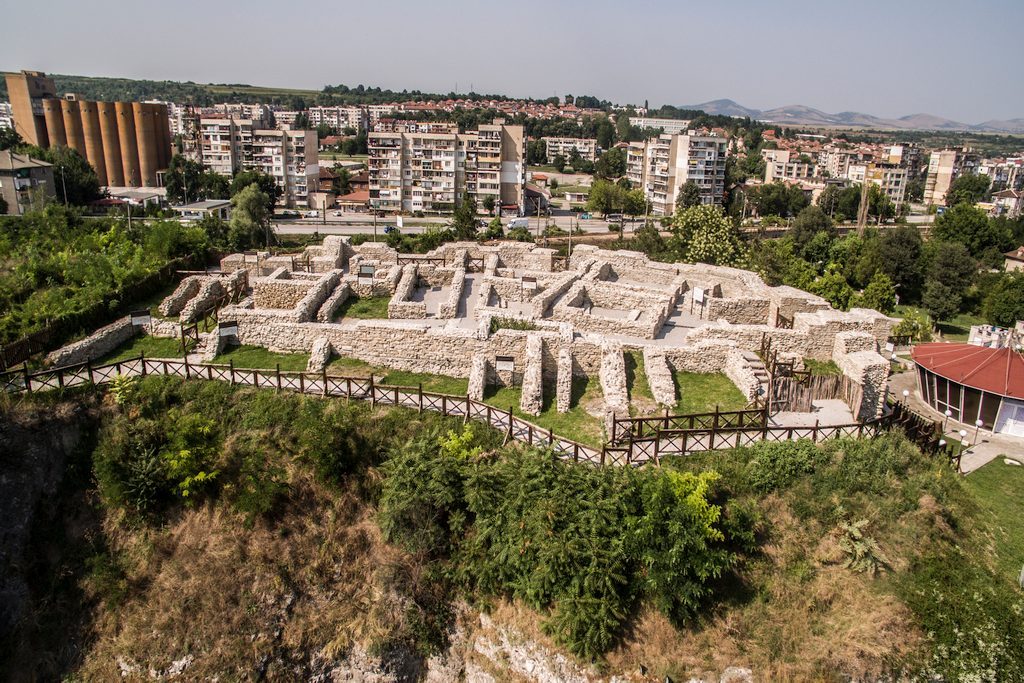

The archeological diggings started in 2003 with the help of the municipality Mezdra. The citadel represents 5 archeological periods from the stone – copper era until the Bulgarian medieval period. More ritual centers are registered, which, functioned in this place throughout the centuries. One of the most attractive discoveries is “Svetilishteto na tura” from the ending of the stone – copper era and original artifacts are exhibited at the regional museum from Vratsa.
In the south – west corner of the city Mezdra, on a high rocky hill dominating the left border of the Iskar River, it is kept from the Ancient history which was today declared at the archeological complex the “Citadel”.
At this turning point of the civilizations there remained the remains of the human history – of copper from the stone era (the IVth millennium b. Chr.). Here, in the antiquity passed the road which connects the Roman city Eskus to Serdika. And until present the place is a center of all the roads which connect the Danube valley with the field Sofia, the east to the west of Bulgaria.
On the hill from above the Iskar river there existed two successive fortified establishments from the end of the years from the stone era and the transition period from the Chalcolithic period to the bronze period, which are destroyed by the conflagrations. From this date, the interval covers the end of the Vth millennium and the first half of the IVth millennium b. Chr. The numerous valuable discoveries demonstrate the fact that a differentiation which clearly distinguishes the handcrafted production. The village is inhabited by the ceramics decorators, the farmers and the jewels which had the raised social status in the local community. One of the most important discoveries from this period was made in 2008, “the sanctuary tournament”, which doesn’t have any analog in Bulgaria. The bivotulera was a pagan deity of the ancient world and the people believed that the world is supported on its corns. In the same place in which there was the “tournament sanctuary”, 2500 years later, there was established the early sacred Thracian structure. The area has been lived by the ancient Thracian tribe from the Ist century, when the establishment was conquered by the Roman empire with all Mizia.
The story of the “fortress” continues through the Antiquity, when in this place there was a Roman fort from the middle of the IInd century, the center of a pagan cult from the IIIrd century and the fortified establishment from the IVth – the VIth century and it evolves in the late Roman period and the early Byzantine period. The fundaments have been set by the pagan sanctuary, which was transformed in a cult pagan center, and now it can be seen situated right above the “tournament sanctuaru”. From this period there can be discovered more bronze coins (antoninianus) from the period of the Roman emperors Domitian, Claudius the IInd, Gothicus and Probus bronze fibulas, ornaments, the belt and the crown of silver laurel leaves. A very rare discovery was made right below the castle’s tower: a bronze distribution of vultures, one of the oldest images of this powerful bird, which symbolizes the supreme Roman God Jupiter (in the Greek mythology, Zeus) and the blazon of the Roman Empire, which expresses the power and the strength. Another treasure is a bronze key found between the remains of the imposing building the “fortress”. Because of the strategic emplacement of the Roman citadel, which is the best conserved citadel from this period in our country, the archeologist suppose the fact that it was opened the symbolical key towards north – west. The late fortified ancient establishment from the hill of the citadel and continued its existence until the end of the VIth century or at the beginning of the VIIth century, when it was destroyed in one of the Avar – Slavic invasions. This was marked at the beginning of the medieval period for the citadel and for the establishment.
During the times of the Great Migration the citadel and the city were destroyed and re-constructed several times. The most recent wave of “barbarian nations” who came in these places was the Slavs. The last ancient coins discovered here are at the beginning of the Byzantine emperor Justin the IInd (the years 565 – 578) and indicate the approximate date of the Slavic establishment. The final of the ancient Bulgarian citadel known under the name of Torbaritsa, was in the XIth century when it wad destroyed by the Turks, when Vasile the IInd launched a campaign against Vidin and captured the Bulgarian lands from north – west.
